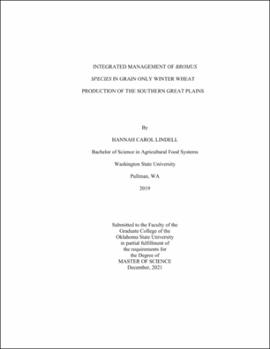| dc.description.abstract | Bromus spp. including rescuegrass, cheat, and downy brome are difficult to manage winter annual grass weeds in southern Great Plains winter wheat. Producers can manage Bromus spp. in herbicide-tolerant wheat, but control in non-herbicide tolerant wheat often is poor. Studies evaluating Bromus spp. management using a combination of planting date delay, competitive wheat cultivar selection, and two common herbicides, were conducted throughout Oklahoma and Texas in 2019-2020 and 2020-2021. Visual Bromus spp. control was evaluated eight to nine weeks after herbicide treatment, collection of Bromus spp. and wheat biomass at heading, wheat head counts, and grain yield. Herbicide treatment decreased Bromus spp. biomass at five of the eight site years. Pyroxsulam at Marshall 2020 reduced rescuegrass biomass 80% compared to sulfosulfuron and nontreated check. Sulfosulfuron at Tipton 2020 and 2021, and Burkburnett 2020 reduced rescuegrass biomass 93%, 77%, and 75%, respectively, compared to nontreated. Pyroxsulam and sulfosulfuron reduced biomass of downy brome and cheat 98% compared to nontreated at Lahoma 2021. Delaying planting date reduced Bromus spp. biomass by 51%, 73%, and 87% at Marshall 2020 and 2021, and Lahoma 2021, respectively, compared to the optimal timing. A planting date by herbicide interaction occurred only at Burkburnett 2020. Herbicide treatment following the optimal and mid-planting dates reduced downy brome biomass by 86% and 94%, respectively, compared to nontreated. For grain yield, planting date affected Tipton 2020 and 2021, and Lahoma 2020. The late planting date resulted in 18%, 46%, and 21% less grain, respectively, than the optimal timing. For both years at Marshall, herbicide treatment affected grain yield. Pyroxsulam and nontreated treatments produced the least amount of grain for 2020 (~3,115 kg ha-1) compared to sulfosulfuron, and pyroxsulam reduced 2021 yield 11% compared to nontreated. Herbicide treatment also increased Tipton 2020 yield ~9% compared to nontreated. Relative to planting date by cultivar interaction, cultivar yield varied at location across four site years as delayed planting decreased yield. Overall, herbicide treatments and/or a delay in planting by two to six weeks after the optimal timing provided a reduction in Bromus spp. biomass but resulted in decreased wheat biomass and grain yield. | |
